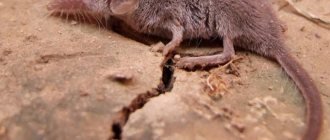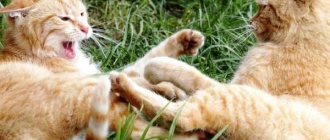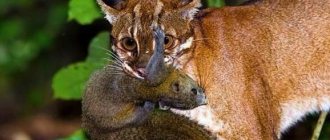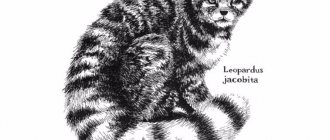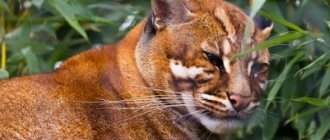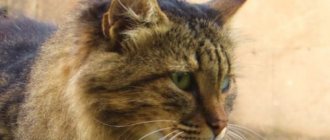Description of the animal
The grass cat, another name for this animal, is the same size as its domestic counterpart. Height at the withers is approximately 30 cm. The body itself is downed, about 75 cm long. Since its fur is too thick, its paws seem slightly shortened. The cat's head is large, with pointed ears. The transition from the forehead to the nose is slightly flattened. The nose itself is large. It is brown in color, often with a thin black border, like the eyes. The fluffy, thick tail is the same length as that of an ordinary cat (25 cm). The animal weighs from 3 to 7 kg.
The Pampas cat is brown in color, but the shade depends on its habitat. It can be light wool in sand tones or any other, up to dark brown, almost black. There is also a pattern that can be pronounced or almost invisible. On the ridge the shade is darker than the main color, and the tail is often decorated with dark stripes.
Description of wild cats
The Pampas cat is a small animal similar to the European wild cat. The animal has a dense body, short legs, a large, convex and wide head. Cats have round eyes, a flattened muzzle near the nose, and oval pupils. The animals have pointed ears and coarse, long and shaggy hair. The tail is also fluffy and quite thick.
Adults can grow up to 76 cm in length, 35 cm in height. The average weight of a Pampas cat is 5 kg. The color of the animal can be silver-gray or black-brown. Many individuals are decorated with unique patterns and rings in the tail area.
Behavior and lifestyle
The Pampas cat is a nocturnal animal that sees well and navigates in the dark. But sometimes the animals go out for a walk or hunt in the daytime. These animals lead a solitary life. Each cat has its own territory that it controls. Typically, property boundaries extend for 30 and sometimes 50 km. These cats, like domestic cats, flee from danger. And at the first opportunity they climb the tree. If there is nowhere to run or the animal encounters an opponent, it raises its fur on end to visually increase in size and scare away the enemy. These cats are often aggressive towards humans, so they are difficult to tame. In captivity they can live up to 12 years.
Nutrition
The diet of an inhabitant of grassy plains consists of small rodents, lizards, insects, birds and their chicks, eggs from destroyed ground nests, and reptiles. The cat obtains food mainly on the ground, although it is not difficult for it to climb a tree.
Keen eyes, ambush duty, quick reaction and quick grasp are typical manifestations of successful hunting for cats. Night vision is an advantage of Pampas animals, although during the day they were seen actively searching for food.
If you come across livestock or poultry, the excitement of getting the prey will prevail over the risks. Humans are the main enemy of grass cats. It was believed that damage from losses of poultry was a significant reason for the extermination of animals. Local residents poisoned them with dogs, and the skins were used for sewing products.
Area
The Pampas cat lives in South America. It can be found in Chile, Brazil, Uruguay, Argentina. She settles in the foothills of the Andes, where she can climb to a peak whose height reaches 5 thousand meters above sea level. In these places they prefer to settle in grassy areas. These are the steppes and pampas (fertile plains with flat topography). It is thanks to their habitat that cats got their name. Animals do not like mangrove swamps, wet forests, or thickets of dried thorny bushes, although they are occasionally found there.
Wild Pampas grass cat: steppe spy
Probably everyone has heard about the Pajero SUV. It turns out that this name was given to him in honor of a small wild cat - Leopardus pajeros, otherwise it is called the Pampas, or grass, cat. Although biologists still do not agree: according to some sources, this is a subspecies of the Pampas cat (Leopardus colocolo), and according to others, it is a separate species. Very little is known about this animal - it leads a very secretive lifestyle, completely unwilling to make contact with humans.
The Pampas, or grass cat, is a small animal, no larger than a domestic cat. It lives in South America, mainly in the pampas - steppes densely covered with grass and devoid of trees.
Therefore, the second name of this cat is grass.
But you can find it in wet mangrove forests, among thorny bushes, and in mountainous areas at an altitude of up to 5000 m.
In total, there are 7 subspecies of this cat, differing in color and behavioral characteristics.
This is not a very large animal. Weight reaches 7 kg, and height - 35 cm. Body length can reach 80 cm, and the tail is quite short - about 30 cm.
Color ranges from black, brown and red to silver. The coat is thick and dense, up to 7 cm long. Depending on the type, the pattern can be pronounced or almost invisible.
The eyes are very large, with oval pupils, adapted to see well in the dark.
These cats are primarily nocturnal, but can also hunt during the day if necessary. They live and get food alone, controlling a territory of up to 50 square kilometers.
They unite in pairs only during the mating season, then the female raises her offspring herself. A litter usually contains one to three kittens.
Despite their short legs, large head and apparent clumsiness, Pampas cats are excellent hunters. They hide for a long time, tracking down prey, and then attack with lightning speed.
When meeting a person, the cat reacts with rumbling, hissing and bristling fur. If the warning was not heeded, the cat fearlessly attacks, without proportioning its strength and size. Females are especially selfless in protecting their cubs.
Their main diet consists of small rodents, but predators do not refuse birds, eggs, lizards and even insects.
Their lifespan in nature is unknown, but in captivity they live up to 16 years.
In the last century, this species of cat was actively exterminated because of its valuable fur; the skins were massively exported from the continent. Only in 1987 was a law passed that severely limited the trade in Pampas cat fur.
In Argentina, Chile and Paraguay, this species is protected nationally and hunting of the animals is prohibited. Expanding human activity is displacing cats from their usual habitats.
Pampas cats have a non-communicative nature, so very few of them are kept in zoos and at home. Their behavior in captivity is characterized by increased nervousness and aggressiveness, and cases of reproduction are very rare. And even in the best home conditions, it will not be possible to raise an affectionate cat from a Pampas kitten.
Pampas cat: interesting facts and information
In the CIS countries, they learned about the grass cat only in our days, since it was identified as a separate species not so long ago. It is distinguished from other brethren by the structure of the skull and the characteristics of its coat. But despite this, some zoologists refuse to recognize the Pampas cat as a separate species. Despite the fact that this animal has been known in its homeland for a long time, there are no published detailed studies and observations about it. So, there are still no details related to the reproduction of these furry animals. The enemy of the Pampas cat is large birds of prey and animals, as well as people who hunt them for their skins.
Reproduction and care of offspring
It is very difficult, if not impossible, to trace how the Pampas cat reproduces in its natural habitat . An obstacle to this is a secretive lifestyle, especially during the period of birth of offspring.
The peak of reproduction of animals living in captivity occurs in April - July and is accompanied by traditional battles for the female. Pregnancy lasts 75 - 80 days. As a rule, two or three kittens are born. Babies are born completely helpless, blind and practically deaf, weighing no more than 100 grams each. Mothers feed on milk for up to three to four months.
Kittens begin to mature in the second week of life, and at one month of age they independently and actively move around the den. At two months the cubs taste meat for the first time, and at four months they go hunting under the supervision of their mother. Six-month-old animals are quite capable of taking care of themselves. Males and females become sexually mature at the age of two years.
In captivity, the mustachioed predator lives 10 - 16 years. There is no reliable information about life expectancy in the wild.
What else to see:
Behavior
Pampass cats are nocturnal, hiding in shelters during the day. They go hunting at dusk and hunt until the morning. They prefer to wait for prey in ambush, hiding in tall grass or among bushes. The victim is overtaken by a lightning-fast throw, killing it with a bite to the neck or the back of the head.
Occasionally, the predator is active during daylight hours. She moves on the ground, but if necessary she easily climbs trees. Each adult has its own home area, which is jealously guarded from any encroachment. Animals are not inclined to communicate with their relatives and live in splendid isolation.
At the moment of fright or aggression, the fur up to 7 cm long on the back stands on end, visually increasing the size of the angry cat. She expresses her emotions by snorting, hissing and meowing.
